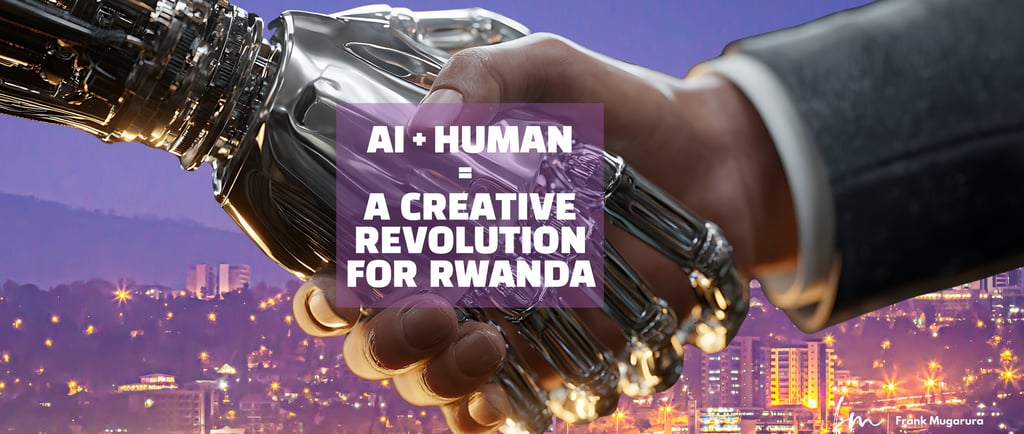AI + Human = A Creative Revolution for Rwanda
This blog explores how the fusion of Artificial Intelligence and human creativity can transform Rwanda’s creative industry,from film and fashion to digital marketing, design, and animation. It offers real-world examples of how creatives, brands, and agencies can leverage AI tools while keeping the cultural authenticity and emotional power of human storytelling. A must-read for Rwandan creatives, innovators, and marketers ready to scale their impact, boost productivity, and lead in Africa’s digital creative revolution.
INSIGHTS
Frank Mugarura
10/19/20254 min read


Rwanda’s creative economy is growing quickly from fashion and film to art, music, design and digital content. But to compete globally, and leverage its unique culture, talent and policy support, the industry needs to evolve. That evolution is happening at the intersection of artificial intelligence (AI) and human creativity. When machines handle routine tasks and humans bring vision, culture and meaning the result is exponential potential.
Here’s how Rwanda can harness that combo, with concrete examples across sectors ,and how practitioners, brands and agencies (like yours) can lead.
Why AI + Human Makes Sense in Rwanda
Young, tech‑savvy population: With a bulk of the workforce under 35, Rwanda has a youthful base ready to adopt digital workflows.
Government backing for creative industries: Rwanda is positioning culture and creativity as central to its economic development.
Creative storytelling rooted in culture: Rwanda’s creative output (art, fashion, film) is rich in local narratives — AI can scale production, humans add meaning.
Access to digital platforms: Creatives can now reach global markets via online platforms (film festivals, design marketplaces) and AI tools amplify capacity.
Need for productivity and competitiveness: AI can help automate tedious work (editing, tagging, effects) so creators focus on innovation and culture.
Key Areas Where AI + Human Can Help Rwanda Stand Out
A) Film & Video Production
AI‑Assisted Editing: Creators film local stories, AI tools help with scene selection, colour correction, subtitles, voice‑overs.
Example: A documentary on Rwandan gorilla tourism, human director captures narrative, AI auto‑edits rough cut and generates English/Kinyarwanda subtitles, freeing the crew to focus on storyboarding and outreach.Generative Visual Effects & Animation: Use AI to create animated sequences (e.g., folklore, graphic stories of Rwandan heritage) that human storytellers refine and localize.
Content Localisation & Metadata: AI transcribes, translates and tags video for local and regional languages; human artists ensure cultural accuracy and tone.
B) Fashion & Textile Design
AI Pattern/Print Generation: Designers input Rwandan motifs and colour palettes, AI generates variations of fabric prints, humans pick, refine and integrate local narratives.
Example: A Kigali label uses AI to produce 50 variations of a “Umushanana-inspired” pattern; designers choose final 5, produce limited collection, highlight local artisan craft story.Virtual Try‑On & E‑Commerce: AI-powered apps let customers see clothes on avatars; human stylists curate looks, tell brand stories, facilitate social shopping.
Supply Chain & Inventory Forecasting: AI predicts demand by region; human teams decide limited editions and “made‑in‑Rwanda” premium runs.
C) Visual Arts & Galleries
AI Curated Collections: A local gallery uses AI to analyse art trends globally; human curators decide which Rwandan artists to showcase internationally.
Generative Art + Human Touch: AI suggests abstract forms referencing Rwandan landscapes; artists add textures, materials, narratives.
Online Exhibits & NFTs: AI tags artwork for global platforms; human curators manage provenance, cultural context, contracts.
D) Advertising, Branding & Digital Marketing
AI Creative Assistants: For brand agencies—AI creates initial visual mockups, headline variants, ad inputs; human strategists refine concept, ensure cultural resonance, brand voice.
Example: A branding campaign for a Kigali coffee brand uses AI to generate social visuals; human team localizes language, embeds Rwandan coffee origin story, edits final creatives.Audience Segmentation & Personalisation: AI analyses consumer behaviours in Rwanda/East Africa; marketers craft tailored messages; human creatives decide tone, story, ethics.
Chatbots & Conversational Marketing: AI chatbots handle routine queries; humans step in for creative brand‑led storytelling, live campaigns, influencer interactions.
E) Music, Animation & Gaming
AI Music Composition: Musicians feed traditional Rwandan melodies into AI; result is baseline tracks; human composers add vocals, instruments, local nuances.
Animation for Kids: AI generates background scenes and rough character motions; human animators refine with Rwandan themes, languages, cultural references.
Game Design: AI helps simulate environment (Volcanoes National Park, Kigali cityscape); game designers integrate local folklore, heritage, tourism stories.
Process: How to Make It Work (AI + Human)
Audit & Map Workflow: Identify repetitive or time‑intensive tasks (e.g., tagging, editing, assets resizing).
Select AI Tools Wisely: Choose tools suited to your creative domain (video editing, pattern generation, copywriting assistants).
Define Human Role: Humans focus on story, culture, ethics, final editing, brand voice, emotional impact.
Generate + Curate: AI produces multiple drafts; humans select, refine, localize.
Test & Iterate: A/B test assets online; learn what resonates in Rwanda/East Africa context.
Measure Impact: Use metrics (engagement, exports, viewer retention, social shares, licensing deals).
Scale Safely & Ethically: Ensure AI usage respects rights, local culture, avoids bias, includes creatives in ownership.
Challenges & How to Overcome Them
Skill Gap: Not all creatives know AI tools. Solution: Training programmes, workshops, partnerships with hubs.
Infrastructure/Access: High‑performance hardware or subscriptions may cost. Solution: Cloud‑based AI services, shared infrastructure, subsidies.
Cultural Relevance: AI models often western‑centric. Solution: Localize models with Rwandan data, have human review.
Story vs Automation: Over‑reliance on AI risks losing unique voice. Solution: Emphasize human‑led story‑telling and cultural authenticity.
IP & Ethics: Clear rights for AI‑generated art/music. Solution: Contracts + transparent ownership frameworks.
A Vision for Rwanda’s Creative Future
Imagine a Kigali‑based animation studio: using AI to quickly prototype animated folk‑stories, human creatives converting them into series that stream globally. Or a fashion label in Musanze: AI helps generate patterns inspired by volcanic ridges; humans craft the story, make the garments, sell globally via e‑commerce. Or local film‑makers: AI reduces editing times from weeks to days, directors focus on story, culture, actors, their films reach global festivals.
The result? Rwanda doesn’t just follow creative trends ,it sets them. It exports culture, artisan craft, digital content, styles with pan‑African relevance. It creates jobs in video production, pattern design, animation, music scoring, game design, AI‑tool operation. It embeds creativity in the economy, not as a sideline but as a pillar.
Call to Action for Creatives & Agencies
Try an AI tool next week: Use it to prototype visuals, then refine with local story.
Form an AI‑Human team: Pair technologists and creatives; meet weekly to map workflow.
Showcase your experiment: Publish as case or project. Attract clients who seek innovation.
Train peers: Offer workshops for junior creatives on AI + storytelling in Rwanda.
Pitch global markets: With AI scale + local story you can access platforms (Netflix Africa, Amazon, gaming portals).
Build ethical guidelines: Ensure culture, story, ownership, rights are protected as you scale.
Conclusion
In Rwanda’s creative industries, the union of AI + human creativity is not a future promise , it’s today’s competitive advantage. AI opens capacity, speed and scale. Humans provide culture, story, emotion and identity. Together, they can elevate Rwanda’s creative output from local to global, from artisan to digital‑export, from jobs to industries. The time to act is now , innovate, collaborate and lead the creative revolution.

